Looking to humanize your brand? Look no further!
In marketing and business, people talk about acquiring customers, they talk about driving sales and many talks about building relationships with their customers.
The latter is a huge deal for brands, and come with its own sets of incredible benefits. You yourself probably have a strategy in place for how you’re going to build your customer relationships.
Unfortunately, though. there are a lot of misconceptions when it comes to building relationships with customers as a brand.
The good news is that brands and marketers understand the importance of doing so, as it increases customer loyalty, customer retention, and ultimately lead to a greater spend.
Here’s something that is huge news for you, though:
The foundation for building customer relationships is first working to humanize your brand.
Why?
Well, here’s the deal:
Humans build relationships with other humans, right?
In other words, while you can have some type of relationship with customers solely as a faceless brand and logo, people will never be able to build truly strong relationships with you.
Humans relate to other humans, yet this is the part where so many brands fall short. In order to humanize your brand, you need to make sure your brand has a real personality and nice which people can recognize and rely on time and time over.
To truly humanize your brand, it must come off as a human! Sounds reasonable, right?
But this also means that you need to take appropriate action to remove everything that creates friction between your customers and your brand when they’re engaging and interacting with their brand.
Back in the days, you didn’t really think the thought to humanize your brand. Brands and customers were quite distant from each other, and in that sense, the way you built ”relationships” with your customers was by putting up more billboards to get in touch with your customers.
Working to humanize your brand is tremendously effective in today’s landscape, as the competition for getting seen and standing out from the crowd is tougher than ever. Instead of focusing on customer acquisition all the time, you can instead humanize your brand to build stronger relationships with you, because stronger relationships lead to greater loyalty – a strategy for increasing revenue that can be far more effective than acquiring new customers.
In fact, the probability of selling to a new prospect is 5-20% whereas the probability of selling to an existing customer is a whopping 60-70%.
What’s more, loyal customers are on average worth up to 10 times as much as their first purchase.
That’s quite significant.
One of the most effective is building customer relationships as it leads to great loyalty,
and being human is the foundation for that.
People don’t build relationships with a logo, they build relationships with a personality.
The catch in today’s society is however that people aren’t really trusting brands. Many people see large corporates as giants that stomp on people and “steal” their money from them. Something that has contributed to this image is the fact that throughout the history of corporates, building customer relationships have, as mentioned earlier, not been something that brands worked on.
The good news is that what was back in the days doesn’t have to be a reality today. But since humans don’t trust brands to a large extent, you need to present your brand as a person – you need to humanize your brand.
In this post, we’re digging deep into a subject that is far from as discussed and talked about as it should be, at least in proportion to how powerful and effective it is.
1. Remove and avoid things that harm your human personality
The worst thing you can do if you want to humanize your brand is to remove the human from it. Sounds logical, right?
You’ve probably come across a website where the writer is named ”Admin” and has no profile picture or bio description.
In building customer relationships, these types of things create friction between you and your audience and can make it harder for people to engage with you.
I mean, it’s hard to build a relationship with a faceless person named ”Admin”, right?
And the thing is that this goes for all type of marketing efforts. You need to steer away from things that make it seem like your brand is run by robots as this can significantly harm the user experience. Do, however, note that this doesn’t mean you can use automation to some extent, it just means that you need to be careful and selective in the way you use it. People want to get to know your brand itself as well as the people behind it, and if you can do that while also using automation, then that’s great.
The problem is that when you use these things, they can create a distance between you and your customers, and this will instead do the opposite as oppose to when you humanize your brand.
The bottom line is that as you begin working to humanize your brand, you need to re-evaluate your current situation so that you are able to build from the ground up and have a solid foundation. Make sure that throughout the whole process of your sales funnel that your customers come in contact with real people with real people that have real names and faces. If you have bots without names in the live chat on your website, you need to exchange that with a real name and a real profile picture.
2.Develop a brand personality and brand voice
It’s no secret that the foundation for building any type of relationships is being human. But in order to be human, you need to have a personality. In fact, almost solely, it is the personality of someone that you relate, resonate, and build a relationship with. This is why when you hear someone say ”you’ve changed”, relationships tend to not last, as one of the individuals in the relationship can’t recognize the person(ality) that they first built a relationship with.
As a brand, it is crucial that you develop and define your brand personality, because as opposed to the personality you have and that you instinctively embrace without thinking about it because estate’s who you are, with a brand, there are often multiple people in the equation, and if the brand personality of a brand isn’t clearly defined, the risk is that when your team speak on your brand’s behalf, they will speak with their own personality and voice.
The problem with this is that it can create the ”you’ve changed scenario” where your existing customers just can’t resonate with your brand anymore and therefore risk distancing themselves from you. Furthermore, for new customers, having them meet different personalities each time they get in contact with you will make it incredibly hard for them to resonate with you, and therefore also build a relationship with you.
This is why, it’s not only important that you humanize your brand, but it is also important that you clearly define what that personality is, so everyone who speaks on your brand’s behalf use the same personality and brand voice.
In developing your brand personality, you want to imagine your brand as a fictional character that you want your brand to be like.
Imagine a fictional character that carries the traits that you want your brand to have. Answer these questions:
- What is the person’s name?
- Who is this person?
- What does this person like and dislike?
- How does this person dress?
- Is this person calm or more active?
Answering these questions will develop a framework for a personality which your brand should embrace, and do when you’ve developed your own fictional character, it becomes much more clear about what type of person you want your brand to be. Not only for you but for your whole team – something that is tremendously important for consistency.
When you’ve defined the personality of the character, you also want to define the way they speak. This is what will then become your brand voice. Also, since verbal communication is the most common form of customer interaction, it is also one of the most important parts of how you humanize your brand.
Answer these questions:
- What is their humor like?
- What tone do they speak in?
- Does the person speak slang?
- Is the person young or old, and does this affect the way they talk?
In developing your brand personality and brand voice to humanize your brand, you shouldn’t only use your own opinions to decide this, though.

After all, remember the whole reason that you’re developing your personality in the first place. It is to humanize your brand, but most importantly, to make your audience resonate with you. But do you think they resonate with you if you have a personality that is completely off from they own personality?
Obviously, if a 10-year old speaks to a person of 40 years, it will be difficult for these people to truly resonate with each other as they are on completely different pages.
The same principle applies if someone from Texas speaks to someone from New York.
Now, that doesn’t mean they won’t be able to build a relationship, but most things that differ between ourselves and someone else work as barriers that can make it harder for people to resonate with you.
This is why you need to have your target audience in mind when developing your personality. If you develop a personality solely off of your own preferences, you might end up with something that’s completely off from your target audience.
As such, it goes without saying that in order to create a brand personality which your audience resonates with, you need to actually know the personality of your target audience.
Now, identifying the personality of your target audience might feel like a tricky task, but it really isn’t. Simply use the questions that are listed above, and then apply that to your target audience. When you have the answers to all of these questions, you can compare your very own fictional character and your target abidance and see if these personalities align with each other.
3. Avoid scheduling social media posts (or do it properly)
That you should do this is quite self-explanatory. Scheduling posts mean letting a ”robot” do the social media posting for you. And when you use robots, you aren’t really humanizing your brand, are you?
Now, don’t get me wrong, I like scheduling tools a lot – they’re amazing tools for streamlining the social media process and saving time, but the problem is that they may increase the gap between you and your audience if used incorrectly. When you’re scheduling social media posts, you’re preparing them in advance, and while you should be able to maintain a human voice, there’s always a risk of decreasing your human touch as people might be able to notice that your posts aren’t coming directly from you right at the spot.
Of course, not using scheduling tools can cause a lot of stress, but if you have the possibility of doing it manually, it’s probably a good idea.
4. Be funny and humoristic
Want to hear something interesting?
All humans like to laugh.
This is great news because it means that no matter who your target audience is, it is a strategy you can leverage.
Laughing is one of the most ”iconic” humanizing traits, and if a human laughs, that’s when you know they’re regular people with regular emotions, opinions, etc. Humor is such a powerful human trait that if you show humor and being humorous, you’ll have a tremendous effect on how you humanize your brand.
Humor connects us humans and has done so for a long time. It has been found that when humans laugh together, they tend to better build a relationship with each other. When you use humor, you remove any sense of ”roboticness” about your brand and show your audience that you are just like everyone else, and someone they can rely on and engage with – a real human being.

The big misconception among some types of brands is that they say ”humor doesn’t work for us”. But the reality is that humor works for all brands, just because of the fact that all humans love to laugh. Sure, the way you use humor might differ based on your target audience, but the principle of leveraging laugh and humor to humanize your brand still remains, and it can have tremendous effects.
Furthermore, many brands are also afraid that by using humor, they lose their professionalism, and yes, if used improperly, humor can harm your brand’s professionalism – but only if you use inappropriate jokes or pull jokes at the wrong times. Also, have in mind that different jokes can be differently appropriate and relevant to different audiences, so make sure you know what is okay and what is not before you jump into it.
The bottom line is that if you want to humanize your brand, you need to embrace one of the most iconic human traits, which is laughing.
5. Join conversations and engage with people
To build relationships with people, you need to actually interact with them. And to humanize your brand, you need to actually interact with your audience.
Just focusing on putting out content, ads, and press releases isn’t a very effective way for you to either build relationships or humanize your brand. Why?
Because it gives your audience no channel to engage and interact with you. No opportunity for them to ask questions and receive responses.
If all you’re doing is using these ”automated” processes, do you think you’ll come off as a human? Of course not, you’ll come off as a robot, because that’s how robots operate.
How robots don’t operate, however, is interacting and engaging with people. A great way to interact with your audience is, therefore, to ask them what they want to see from you. Not only does this show your audience that you care about them (emotions), but it also allows you to craft content which your audience will find more relevant.
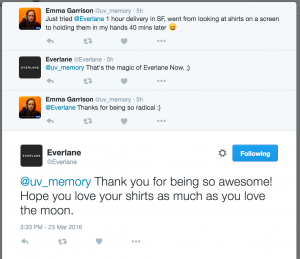
Essentially, you want to take part in every single conversation you can and engage with your audience as much as you can. That this is a strategy for humanizing your brand isn’t a surprise, really, because this shows that you care about them and that you value them immensely.
Again, building relationships and humanising your brand are very closely aligned, because when you build relationships with your audience, they become more loyal, and when they become more loyal, they have a much easier time resonating with you, thus allowing you to humanise your brand by showing that you actually are a real person as you’re engaging with them.
Obviously, the more you engage and interact with your audience and take part in the conversations, the more you’ll be able to humanize your brand. This is why, despite resulting in a lot of work, you want to take part in all the conversations that you can, and every opportunity you get to engage with your audience. This includes face-to-face conversations, social media complaints, forums online, and everything in between. The more you engage with our audience, the more you’ll be able to show you are actually human.
6. Identify the things that your audience will resonate with
Creating content that your audience will resonate with is fundamental for not only engaging with them but also to show them that you listen.
Obviously, if you have no value proposition, nothing of value, whether it be an ad or a social media post, it will be hard to get your audience to you. And getting your audience’s attention is the first step to engaging and interacting with them.
Social listening is a tremendously effective approach to use in order to identify what your fans like and dislike. If you want to do marketing research more extensively, you can even run surveys. The more relevant your content is, the more you show that you pay attention, and the more you’ll be able to humanize your brand.
In that sense, it’s all connected.
7.Be Transparent
Transparency is everything.
If you aren’t transparent as a brand, you’ll have a harder time humanizing your brand, and at the same time, your audience will have a harder time trusting and resonating with you.
The worst part about not being transparent is that it seems, from the public point of view as if you have something to hide.
You’ve probably found that the people who are the most truthful and most honest are the people that you have the easiest time resonating with, and the truth is that the same principle goes for brands.
We’ve been living in this business landscape for the last decades where brands are terrified to be transparent and what is happening behind the scenes. Therefore, the culture of companies has been to show as little of behind the scenes to the public as possible, and because everyone was doing that, it wasn’t something that people complained about. Now, however, we’re beginning to see a shift in brands’ transparency. Sure, most large corporates that existed back in the days are, not surprisingly, as secretive as they’ve always been, but as new brands are joining the party, they’re also coming with new ideas and ways to run a company, and for many of them, this includes being tremendously transparent.
As humans, we don’t really like when people or brands are secretive. Because when they are, it sends the signal thatchy got something to hide – something they aren’t proud of.
On the flip side, if you don’t have anything to hide, you have everything to win by being transparent.
Nordstrom is a brand that has greatly embraced transparency by doing everything from talking about their factories and where they are from, what challenges they are facing, who their team consists of, and much more.
The best part?
You might think that because Nordstrom says that most of their factories are based in Asia etc, that they’ll be faced with criticism and complaints, but it is actually the opposite. Also, the best part is about being transparent is that if you’ve already presented every single thing about yourself, there’s nothing people can do against you that will damage you.
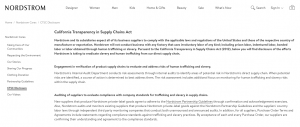
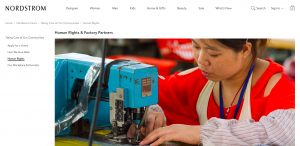
There are endless ways which you can use transparency and become more transparent, but the best way is to start with the questions that people are asking the most. It might be where your factories are, what you’re doing to take responsibility for nature, and so on. Furthermore, your people and offices are also things that you can show that have a tremendously positive effect on how well your audience resonates with your brand and how much they trust you.
Because when you have already told every single truth about your brand, don’t you think people will trust you more?
Far too many times, I’ve (and probably you too) seen people asking brands questions that seem to be sensitive to the brands, and either they don’t get answers at all, or they get a half-ass answer which doesn’t really answer the question. The problem is that when this happens, it gives birth to a lot of skepticism. Quite instantly, people start wondering if the brand has something to hide and if there’s something that they aren’t proud of. This is, of course, one of the most damaging things if you look at humanizing your brand.
Southwest even took transparency so far that they invented a new word to describe their work: transfarency.
Quite a clever marketing move if you ask me.
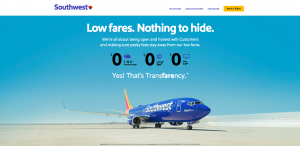

8.Emphasise building relationships on social media
You’ve probably figured that the single most effective tactic to humanize your brand is to engage and interact with your audience. The more you build customer relationships, the more people will trust you and resonate with you. In other words, you will have humanized your brand.
Think about it:
The people you know the best are the people you’ve engaged and interacted with time and time over. As a result, these are also the people you know that have a great personality, which includes emotions, opinions, thoughts, and everything in between that are common traits for a human.
The same also goes for you as a brand. Not only do you improve your customer relationships when you engage with your audience, but at the same time, you’re also giving yourself more opportunities to show your brand’s true personality. This means, that the more you engage, the people will see your personality, and thus realize that you’re not just a faceless logo.
The single best place to build customer relationships is hands down social media. Today, more people than ever are using social media, and the number of users isn’t decreasing any time soon. Furthermore, social media give tremendous opportunities for you to identify your target audience, for example by looking at interests, and so on. But best of all is that many of the conversations that people previously had face-to-face have now moved to social media. This, of course, also includes the conversations they have about brands, including yourself.
Therefore, by leveraging social listening and identifying the conversations people are having about your brand, you can find the people that are most relevant and thus best to engage and interact with.
Social media allows for effortless and instant communication with your audience in a way that just wasn’t possible a few years ago, so take advantage of this opportunity to show that you have a personality.
I’ve mentioned this example a million times already, but that’s because it is such a great example. I am talking about Wendy’s social media strategy and the way they engage and interact with their audience on social media.
Through their messages, they do everything right in crafting messages that humanize your brand. They use humor (a lot of it), they show emotions, they laugh, they cry, and everything in between. The most important part, however, is that they’ve clearly found and defined the brand personality and voice they want to have, they’ve locked it in, and now, they use it consistently.

9. Be available and give fast responses
Okay, so if conversations and interactions are the foundation for building relationships, which, in turn, are the foundation for humanizing your brand, you obviously need to do more of it.
But while taking initiative yourself is a tremendous idea, you also need to make sure that you are available and respond to all of the people who write to you.
This includes all channels through which people can reach out to you from, such as email, phone, forums, but most importantly, social media.
Where your customers are, that’s where you need to be, but if you’re not, you’re firstly missing out on tremendous opportunities to humanize your brand and build relationships, but you’re also leaving your customers hanging, which has a tremendously negative effect on their attitude towards you.
In fact, Sproutsocial found that 24.7% think that not receiving a response from a brand on social media is an ”annoying action”.
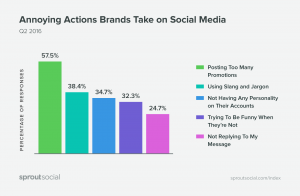
With that fact that interactions are so important for humanizing your brand, you obviously want to encourage everyone to reach out to you so you can let your brand’s human sides shine through.
Furthermore, you don’t only want to make sure you respond to your messages, though. You also want to make sure that you respond quickly to them as well.
The same SproutSocial study found that on social media, people expect brands to respond within 0-4 hours, but unfortunately, that is not the case as the average response time is 10 hours.
Now, taking the initiative to start conversations as a brand demands both time and effort. First, you need to find your prospects and then reach out to them, but when your audience is taking initiative, you don’t have to do that. This is why the easier you make reaching out to you, the more people will do it. In the same way, the faster you respond to people who message you, the more people will reach out to you, resulting in more opportunities to show your brand’s personality, and thereby humanize your brand.
Remember that this doesn’t just go for social media, but for all channels which your audience can reach you through. What’s more, it is crucial that you don’t set up profiles on various platforms if you don’t plan on using them, because what will happen is people will reach out to you, and they’ll receive zero responses.
10. Speak in the same language as your customers
I’ve already spoken briefly about this already in the context that you’re going to develop your brand voice and personality, but let me elaborate a bit on this.
The world has changed, and no longer do people want to hear brands talk in their corporate-speak that has no soul or personality. Developing your brand voice is one of the most important parts to humanize your brand, but what is even more important is that you align this voice with your audience. Obviously, if you’re targeting teens, you shouldn’t be using the terminology that 60-year olds are using, and vice versa of course. You need to develop your voice so that when your audience talks to you, it’s like they’re talking to their best friend.
When you create a brand voice to which your audience can relate to, they’ll actually want to engage with you.
11.Showcase your team
A business is not a business without the people behind it. In fact, it is the people that make the brand, and everyone knows that. Showcasing your team is a form of transparency, and it is, hands down, the most important form of transparency. If the people who are working behind your brand can’t be leveraged to humanize your brand, I don’t know what can.
There are endless ways to showcase the team that is making your brand work, and that helps your customers get their products. Furthermore, your customers are in contact with your brand in one way or another throughout their purchase process, but for most businesses, they never get to know who they are talking to what person sent out their order, and so on.

First off, begin by presenting all your co-workers on your website. This is an easy way to let people know what people are standing behind your brand, and which people they might come in contact with under which part of the customer journey.
One of the most common ways you see brands leveraging their co-workers to humanize is by having them end all their messages with their name. Not only does this help show customers that they’re talking to a real person, but it also helps them keep track of who did what. The best part is that it can also contribute to your audience having an easier time building relationship with your brand, as they have an easier time resonating with you when they talk with a real person and not just a brand. To take it one step further, you should also add a picture of the people who are managing your customer service/interactions, because obviously, having real humans humanize is the best way to humanize.
12. Take your audience behind the scenes
Sharing behind the scenes content is one way of becoming more transparent, but sharing this type of content also makes your audience more engaged in you.
By taking your audience in on the process, your audience will become much more engaged in what it is you are doing since you now make them a part of the process.
Obviously, you’d value a shirt that you’ve put countless of hours into knitting compared to one that you bought for a couple of dollars, right?
This is what the power of inclusion does for brands.
13.Leverage emotions
Emotions are what make up a human’s personality to a large extent, and so this means that if you leverage emotions, you’ll be on your way to humanize your brand.
Now, I’ve already spoken about humor, but fortunately, there are a number of emotions that you can leverage in your marketing as well.
By showing that you have emotions as a brand, you show real human traits which help you come off as more human and relatable.
When interacting with your audience, share your thoughts, ideas, opinions, and emotions, because these are the things that make humans human.
14. Be authentic and genuine
There’s nothing people love more about brands than when they are authentic and genuine.
If you are inauthentic, you’ll be exposed quickly. Especially in this social media landscape where fakers are cracked down on hard by other people. Back in the days, brands could lie about things and screw people over for a long period of time without much happening because information traveled so slowly. However, if an order is one day late to deliver, or if a hamburger is cold, people will know about it. That’s because information is traveling at the speed of light now that the internet has come around.

The worst part about lying and being inauthentic is that once you are exposed, you’ll significantly harm your brand’s trust, and this is something that isn’t exactly something that will help you humanize your brand if I put it that way.
Sure, lying to your customers can give you short-term benefits, but in the long run, being authentic and genuine always win.
15.Involve your team members in the conversation
Two ways to humanize your brand is to have your team members end their messages with their name, and further dd a profile picture when talking to customers on the web, which I talked about earlier. Doing so is a great start, but if you want to go even further, involving your team members is a tremendous idea.
In recent times, more and more CEOs have started to use social media to interact with their audience, give fans of their brands behind the scenes insight, share their thoughts, ideas, and everything in between. One of the most well-known CEOs on social media who regularly share his thoughts and ideas on social media is Elon Musk, CEO of Tesla and SpaceX.
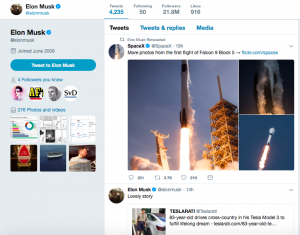
His weapon of choice is Twitter, where he daily share tweets about his brands and what is going on behind them. Doing this has shown to be tremendously effective for several reasons, but the most important part is that he engages his audience and brings them with him on his journey. As a result of this, and not holding back on his personality, he has been able to build a devoted audience of fans that look up to both him and his brands.
Remember that it is the people that make the brand, and therefore, having the people talk on behalf of themselves, but at the same time clearly show that they represent the company is an incredibly effective way to humanize your brand.
Also, don’t believe that you have to be a CEO to do this. Essentially anyone from the team can and should use social media to share with people who are passionate and interested in your brand what they are doing and the day-to-day activities that make the brand that people love so much work. You’ve probably seen that some brands have created social media accounts dedicated to special teams within your organization. Entrepreneur Gary Vaynerchuk’s team has created a social media account by the name of @Teamgaryvee on Instagram where they share their day-to-day activities with the word, which gives the fans of Vaynerchuk an insight look into what goes into everything he does.
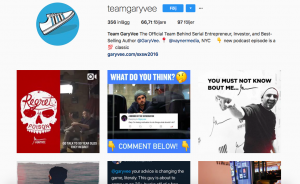
Furthermore, they also share posts where they introduce the different team members and tell people more about them. Since most team members are operating behind the scenes in most businesses, they seldom get any credit for their work from a public perspective, but when doing this, you can let your fans know who does what.

In doing this, don’t forget that interacting is key. Make sure you always engage and interact with your audience and answer any questions people might have.
16. Share your mission
All brands have a mission.
For Nick’s, that mission is to improve the world of snacks by reducing or removing the amount of sugar in them.
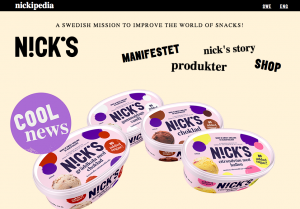
This is a huge pain point for many people who want to enjoy a delicious snack but without the sugar. It’s a mission people can relate to and one that many people support.
Now, how can you humanize your brand by sharing your mission? By bringing your audience on board it, of course!
All humans have dreams and goals, and by showing your brands mission and leveraging your team to spread that message, you can make people resonate with you in a better way, and most importantly, become devoted fans who spread your mission.
Have your team emphasize the problems that your brand is solving, and leverage them to tell your audience about the mission that they’re so deeply passionate about that they have decided to join your brand.
17. Humanize your brand: Show gratitude
Your fans give up some of their time to engage with your brand, to support it, and even be evangelists where they go out of their way to spread your message because they believe in it so much. These individuals bring you tremendous value, and you need to make sure that you bring them value back. There are numerous ways to do this, but it all starts with showing gratitude and thanking them for their support.
Never forget where you came from, but most importantly, remember that how you got here wasn’t solely because of your own skills, it was also with the help of the people that support you and help you accomplish them.
If people time and time over support you, help you, and bring you tremendous value, but then feel like they aren’t even acknowledged for it, there’s a risk that eventually, they’ll get tired and go somewhere else. In the worst case, they might leave you for your competitors. Therefore, you need to make sure that these people feel loved and appreciated in all ways you can.
Firstly, humans love to feel acknowledged and appreciated. In fact, William James once said that the deepest principle in human nature is the craving to be appreciated, and that is to a large extent very true.

The best part is that if you can be the one that gives these people the feeling of being appreciated, you dramatically increase the chances of them staying with you, and becoming even more loyal to your brand.
While giving them gifts and presents to show them your appreciation is a great idea, it is not necessary, because going out of your way to thank them will take you a long way.
People love to feel like they’re part of something larger than themselves, and if you can give them confirmation that they are, by letting them know that they have contributed to getting you where you are, that means a lot.
A great way to do this, apart from sending them personalized messages where you thank them, is highlighting your most devoted fans. Make a post about them on social media, include them in your newsletter, or creating a page on your website where you highlight your fans. The possibilities are endless, but they all help you do the same thing: show your gratitude towards your fans.
Remember that by rewarding wanted behavior, you’ll see more of that behavior, and this means that by showing gratitude, you not only humanize your brand, but you also make your audience more likely to continue to do what they are doing to support you.
Hemtex, an interior brand, has, for example, created a page on their website where they showcase their audience’s social media posts of their products:
18.Provide value
Providing value to your audience in any way you can is key to humanize your brand. This is especially important on social media.
To humanize your brand, you need to engage and interact with your audience, and to do so, you need to actually have people to come to you, and most importantly, have people want to come to you. To get them to do so, you need to have a value proposition, which means providing something of value that they’ll actually want to come to, as opposed to let’s say ads, where you force your audience to watch it.
In order to be able to do this, you need to get to know your audience and understand their needs. Are they using social media for entertainment? Are they coming to your brand to learn more about you, or do they come because they want special deals and offers? Maybe, they are hoping for giveaways of your products?
Since, on social media, you’re, to a large extent often rely on organic reach, this is even more important because if you’re only putting out things that are benefiting you, but aren’t bringing any real value, they’re only a click away to never hear from your brand again.
Rather than focusing on your own needs, focus on your audience’s needs, and the best part is that when you do this, your own needs will eventually be met because of the psychology of reciprocity.
To humanize your brand doing this, go out of your way to ask your audience to show them that you care about them – not just their money.
By sharing content they care about, you’ll naturally include them in the conversation and make them more likely to engage with you – thus giving you opportunities to make them more loyal, which also helps you humanise your brand. A win-win in other words.
19.Understand that social media is different from advertising
Continuing on the previous point, to succeed on social media, you need to focus on your audience’s needs, but unfortunately, this is where many marketers screw up.
They think that social media works the same way as traditional advertising where the more ads and promotional content you shove in your audience’s face, the better marketing results you’ll generate, however, this is obviously not the case.
The fact is that you promote more by actually promoting less. Crazy, right?
Instead of focusing promotion, focus on the conversations with your customers, because social media is a relationship tool, and this is where you’ll see the most success from.
Conclusion
Transparency and being human as a brand are two of the most important traits to have as a business in today’s business landscape.
Back in the days, these were two traits that no business embraced as it was the businesses who controlled the messages and the consumers had no voice, but today, with the internet and social media, it has become more important than ever, since consumers can share their experiences with a brand in a matter of seconds with the world. By working to humanize your brand, you bridge the gap between you and your customers, and make it easier for them to resonate with you. As such, humanizing your brand will lead to stronger customer relationships and a more engaged and loyal audience. The reason is that when brands are transparent, they make it easier to resonate with them because humans resonate with humans.

